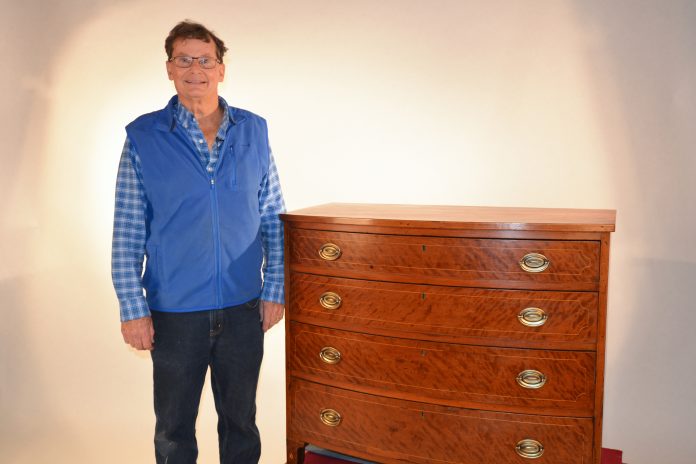by Kathy Tretter
A few more than 200 years ago — just as Indiana was gaining statehood in 1816 — a family of four packed their belongings and moved from Kentucky to a small settlement in the new 19th state known as Little Pigeon Creek.
The husband and father was a talented furniture maker with a magnificent set of tools to ply his trade. He was also artistic and particular in his craft.
Sadly, history has not remembered him fondly, which likely can be laid down to a marketing ploy designed to get his son elected president, making the claim the father was a shiftless, illiterate ne’er-do-well and the son was entirely a self made man who came from nothing.
The son, as readers will already have guessed, was Abraham Lincoln and the father was Thomas Lincoln.
Flash forward a couple hundred years.
Steve Haaff, of Patronville, became fascinated with Federal style furniture many years ago. The former educator decided to educate himself on the furniture Thomas Lincoln crafted by hand. He educated himself to the point of replicating Thomas Lincoln’s tools and recreating certain pieces of furniture. He made patterns from the designs and became so knowledgeable that Haaff — a Spencer County native — is considered the world’s foremost authority on Thomas Lincoln furniture. He has been contacted by people the world over, including those fine folks at Antiques Roadshow, to authenticate (or debunk) a claim of a Thomas Lincoln-made item.
A couple years ago he received a call from a family in Kansas who had a dresser that family legend claimed was made by Thomas Lincoln.
Without going into the details of Haaff’s investigation (lacking an entire book to write), he was able to confirm the four drawer dresser or bureau had been crafted by Mr. Lincoln. In fact, it was a piece Haaff had been looking for over many years.
Read the whole story in this week’s issue of the Spencer County Leader!
Featured Image: By day’s end, Lincoln furniture expert Steve Haaff had the alterations made to the historical piece, and it was ready for the unveiling. Haaff is pictured here with the finished piece crafted by Thomas Lincoln








Verifying the piece: Haaff investigated every inch of this historical chest dresser to verify that it was indeed a creation by Thomas Lincoln














Restoration: After verifying the piece had been in fact made by Thomas Lincoln, Haaff set out to restore the piece to its former glory

The chest drawer made by Thomas Lincoln began its restoration progress to eventually be unveiled in the Indiana State Museum









It’s all in the details: Close-up shots reveal the fine craftsmanship and detail Thomas Lincoln put into making this chest dresser, as well as his signature star that he notably put on all of the furniture he crafted in his lifetime


Original parts that were carefully removed from the chest dresser included nails and brackets




Other artifacts that are present at the Lincoln exhibit












The piece was unveiled in the Lincoln exhibit at the Indiana State Museum along with other pieces crafted by Thomas Lincoln

Cousins, some who may not have met before, gathered for a snapshot at the Indiana State Museum. Pictured from left: Mike Schaaf, Shirley Fouse, Julie McIntire, Mildred Moore, Bud Schaaf, Ken Schaaf and Karen Yudnich, with Steve Haaff, who was responsible for authenticating the dresser as a Thomas Lincoln-crafted piece and for making repairs to restore it to its former glory.







I am certainly not complaining about Steve Haaf’s work. He is admired by all and now I’m reading by all over the world. For me there is admiration of his restorations and replica’s of Lincoln artifacts at the Lincoln Pioneer Village in Rockport Indiana. But I also wonder at the restoration done on the recent Lincoln dresser erasing it’s 200 years in travel. The fact that it was able to be restored to such magnificence is mind boggling but I feel it’s 200 year journey is remarkable as well.
Could it have been left as found, notating each repair over time to keep it viable, why it was needed at the time and an information placard placed on the dresser in the museum. That would have been a learning experience of the past as well as its true history.
[…] This article originally appeared in Spencer County Online. […]
Comments are closed.